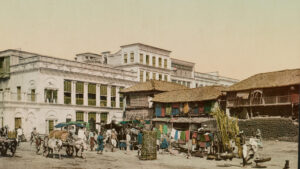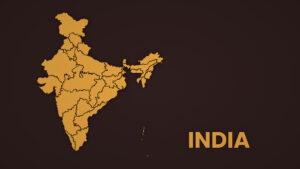The earliest humans of several types in the hominid line appeared on earth about 6 million years ago and were close to apes. The remarkable species in the evolution of humans was Australopithecus, as it resembled human characteristics and was the last of the hominids that existed during the Pliocene and Pleistocene epochs. The species of Australopithecus is called protohuman. The first species of humans that exhibited some skills to break stone into pieces to make tools was Homo Habilis.
The next development in the hominid species was Homo Erectus, an erect man who discovered fire and learned the ways to use it and created a specific tool like a handaxe. Since the remains of this species were found in various parts of the world, experts believe that Homo Erectus travelled long distances. Homo Erectus were cave dwellers.
Subsequently, Homo Sapiens emerged in the line of hominid species. Homo Sapiens were cave dwellers who lived in groups and hunted for food. Homo Sapiens have a resemblance with Homo Neanderthalensis. After this, the modern man called Homo Sapiens Sapiens originated with more effective skills than his predecessors, creating sophisticated tools for various purposes and capabilities to modify the environment.
Other than discovering a few fossils correlating to human evolution, the distinct records available are insufficient to establish the facts about the existence and settlements of primitive men in India. However, the remains of Homo Sapiens Sapiens were found in the Pahiyangala caves in Sri Lanka. According to the theory of great coastal migration (also called southern dispersal), the earliest modern humans arrived in India from the south via the Arabian peninsula between 70,000 – 50,000 BCE.
THE PALAEOLITHIC AGE IN INDIA
The term “Palaeolithic” is derived from the Greek words palaios, meaning old, and lithos, meaning stone; therefore, the Palaeolithic age is often called the old stone age. Since the earliest humans used only rough stones as tools in their daily lives, the name “Palaeolithic Age” is applied to recognize the age of their existence.
Based on the type of stone tools and climatic changes, the Palaeolithic age in India is classified into three phases:
1. Lower Palaeolithic (600000 – 150000 BCE)
The life and habits of the earliest inhabitants of this phase hunted animals and gathered raw fruits and vegetables for food, and they lived in constant dread of wild animals with no fixed home. Palaeolithic men of this period used cleavers and hand axes made out of crude stones primarily for hunting animals, skinning, chopping and digging.
In India, Bori in Maharashtra is the earliest site of the old stone age, and other important areas include:
- Belan valley in Uttar Pradesh
- Renigunta and Kurnool caves in Andhra Pradesh
- Bhimbetka and Jogdaha in Madhya Pradesh
- Bagor and Budha Pushkar in Rajasthan
- Patne and Nadnipalle in Maharashtra
- Singhbhum in Jharkhand
2. Middle Palaeolithic (150000 – 35000 BCE)
Although middle Palaeolithic inhabitants led a life similar to that of lower Palaeolithic men, the characteristic feature exhibited by the inhabitants in this phase is that they started making pointed or sharpened tools such as blades, flakes, pointers, borers and scrapers that eased them in hunting fish and birds.
Most of the lower Palaeolithic zones overlap with middle Palaeolithic zones such as Belan valley, Bhimbetka, Bagor and Singhbhum. The discovery of artefacts of this age was in the following major locations:
- Nevasa in Maharashtra
- Narmada valley in Madhya Pradesh
- Karmali valley and Didwana in Rajasthan
3. Upper Palaeolithic (35000 – 10000 BCE)
The last phase of the Palaeolithic age, clashing with the end of the ice age, witnessed a drastic change in the climate, which was much warmer than the earlier phases. The inhabitants of this period dwelled in caves and rock shelters and used flint tools with bevelled points. It is unclear, with available records, that the upper Palaeolithic people lived and hunted in groups.
Significant sites of the upper Palaeolithic age are:
- Belan valley in Uttar Pradesh
- Kurnool caves in Andhra Pradesh
- Nevasa in Maharashtra
- Sabarmati valley in Gujarat
- Narmada valley, Azamgarh and Hathnora in Madhya Pradesh
- Pahalgam valley in Jammu & Kashmir
INTERESTING FACTS ABOUT THE PALAEOLITHIC PEOPLE
- The inhabitants of the old stone age mostly used quartzite, a species of hard rock, to make stone tools. Therefore, the Palaeolithic men are also known as “Quartzite men”. They belonged to the Negrito race.
- The Palaeolithic people might have lived in small groups and shared the hunted or gathered food among others. They consumed animal flesh and gathered fruits but had no thought about agriculture. They might have also lived in small huts made of tree branches, bones, bushes and dry grass.
- The people of the old stone age painted the figures of various birds, animals, men and women and depicted hunting and food gathering. The amazing Palaeolithic site that shreds the evidence of prehistoric rock paintings is Bhimbetka caves in Madhya Pradesh.









